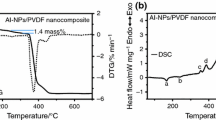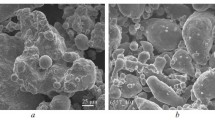Abstract
The composite powders of nanoscale aluminum (n-Al) and iron fluoride (FeF3) were prepared by an ultrasonic mixing method. The microscopic morphology was examined by scanning electron microscopy, the crystalline phase structure was analyzed by X-ray diffractometer, and extensive thermal analysis of the single components and composites was carried out, focusing on the thermal reaction properties of n-Al/FeF3. The reaction process and pre-ignition reaction of the complexes were investigated by characterizing the reaction products of n-Al/FeF3 and Al2O3/FeF3 at certain temperatures. Finally, the apparent activation energy of the thermite reaction of n-Al/FeF3 was determined using the Ozawa method, the Flynn method, and the Starink method. Under an Ar environment, n-Al/FeF3 could react at a lower temperature (613.8 ℃) and give off more heat (1097.0 J g−1) compared with n-Al/Fe2O3. In the air environment, n-Al/FeF3 also showed a lower reaction temperature (509.7 ℃). N-Al could be totally oxidized at a lower temperature with a higher degree of reaction, although the reaction heat release (1477.6 J g−1) was lower than that of n-Al/Fe2O3 (2692.5 J g−1). A pre-ignition reaction occurred before the main reaction of n-Al/FeF3, but no evident exothermic peaks were found in the thermal analysis. The activation energies of exothermic peaks 1 and 2 for n-Al/FeF3 were 113.79 kJ mol−1 and 185.45 kJ mol−1, respectively, slightly higher than those of n-Al/Fe2O3. The study results reported in this work provide a certain reference for the in-depth research and application of the n-Al/fluoride thermite system, as well as fresh ideas for the development of novel nanothermite materials.









Similar content being viewed by others
Availability of data and material
The data that support the findings of this study are available from the corresponding author upon reasonable request.
References
Sundaram D, Yang V, Yetter RA. Metal-based nanoenergetic materials: Synthesis, properties, and applications. Prog Energy Combust Sci. 2017;61:293–365.
Séverac F, Alphonse P, Estève A, Bancaud A, Rossi C. High-energy Al/CuO nanocomposites obtained by DNA-directed assembly advanced functional materials. Adv Funct Mater. 2012;22:323–9.
Kappagantula KS, Farley C, Pantoya ML, Horn J. Tuning energetic material reactivity using surface functionalization of aluminum fuels. J Phys Chem C. 2012;116:24469–75.
Wang Y, Li Z, Yu H, Feng C. Reaction mechanism of metastable intermolecular composite. Prog Chem. 2016;28:1689–704.
Reese DA, Wright DM, Son SF. CuO/Al thermites for solid rocket motor ignition. J Propul Power. 2013;29:1194–9.
Apperson SJ, Bezmelnitsyn AV, Thiruvengadathan R, Gangopadhyay K, Gangopadhyay S, Balas WA, et al. Characterization of nanothermite material for solid-fuel microthruster applications. J Propul Power. 2009;25:1086–91.
Valluri SK, Schoenitz M, Dreizin EL. Metal-rich aluminum-polytetrafluoroethylene reactive composite powders prepared by mechanical milling at different temperatures. J Mater Sci. 2017;52:7452–65.
Ao W, Liu X, Rezaiguia H, Liu H, Wang Z, Liu P. Aluminum agglomeration involving the second mergence of agglomerates on the solid propellants burning surface: Experiments and modeling. Acta Astronaut. 2017;136:219–29.
Armstrong RW, Baschung B, Booth DW, Samirant M. Enhanced propellant combustion with nanoparticles. Nano Lett. 2003;3:253–5.
Kuo KK, Risha GA, Evans BJ, Boyer E. Potential usage of energetic nano-sized powders for combustion and rocket propulsion. MRS Online Proc Libr. 2003;800:39–50.
Pantoya ML, Granier JJ. Combustion behavior of highly energetic thermites: Nano versus micron composites. Propellants, Explos, Pyrotech. 2005;30:53–62.
Wang YJ, Guo L, Jiang ZS. Influencing factors of high-pressure discharge nanothermite composites based on Al/Bi2O3. Combust, Explos Shock Waves. 2019;55:184–90.
Wang YJ, Yu HY, Jiang ZS, Guo L. Improved pressure discharge property of surface modified Al/Bi2O3 composites. Russ J Appl Chem. 2017;90:1330–6.
Friedman R, Maček A. Combustion studies of single aluminum particles. Symp Int Combust. 1963;9:703–12.
Pantoya ML, Dean SW. The influence of alumina passivation on nano⁃Al/Teflon reactions. Thermochim Acta. 2009;493:109–10.
Osborne DT, Pantoya ML. Effect of Al particle size on the thermal degradation of Al/Teflon mixtures. Combust Sci Technol. 2007;179:1467–80.
Hobosyan MA, Kirakosyan KG, Kharatyan SL, Martirosyan KS. PTFE-Al2O3 reactive interaction at high heating rates. J Therm Anal Calorim. 2015;119:245–51.
Koch EC. Metal-fluorocarbon based energetic materials. Weinheim: Wiley-VCH Verlag GmbH & Co. KGaA; 2011. p. 373–9.
Gangal S. Kirk-Othmer encyclopedia of chemical technology. New York: Wiley-VCH Verlag Gmbh; 2000.
Wang J, Zhang L, Mao Y, Gong F. An effective way to enhance energy output and combustion characteristics of Al/PTFE. Combust Flame. 2020;214:419–25.
He W, Liu PJ, Gong F, Tao B, Gu J, Yang Z, et al. Tuning the reactivity of metastable intermixed composite n-Al/PTFE by polydopamine interfacial control. ACS Appl Mater Interfaces. 2018;10:32849–58.
Li Y, Li J, Wang B, Ma H, Han Z. An approach to the induced reaction mechanism of the combustion of the nano-Al/PVDF composite particles. Surf Coat Technol. 2022;429: 127912.
Collard DN, Fleck TJ, Rhoads JF, Son SF. Tailoring the reactivity of printable Al/PVDF filament. Combust Flame. 2021;223:110–7.
McCollum J, Pantoya ML, Iacono ST. Catalyzing aluminum particle reactivity with a fluorine oligomer surface coating for energy generating applications. J Fluorine Chem. 2015;180:265–71.
Campbell LL, Hill KJ, Smith DK, Pantoya ML. Thermal analysis of microscale aluminum particles coated with perfluorotetradecanoic (PFTD) acid. J Therm Anal Calorim. 2021;145:289–96.
Valluri SK, Schoenitz M, Dreizin EL. Combustion of aluminum-metal fluoride reactive composites in different environments. Propellants, Explos, Pyrotech. 2019;44:1327–36.
Koch E-C, Weiser V, Roth E, Kelzenberg S. Magnesium/xenon (II) fluoride (MAX): A new high energy density material. 35th Int Pyrotech Semin, Fort Collins, Colorado, USA. 2008; 695–9.
Jiang A, Xia D, Li M, Qiang L, Fan R, Lin K, et al. Ball milling produced FeF3-containing nanothermites: Investigations of its thermal and inflaming properties. ChemistrySelect. 2019;4:12662–7.
Liu P, Li X, Cheng L, Zhu X, Li Y, Song D. Preparation and characterization of n-Al/FeF3 nanothermite. Chem Eng J. 2018;331:850–5.
Valluri SK, Bushiri D, Schoenitz M, Dreizin E. Fuel-rich aluminum-nickel fluoride reactive composites. Combust Flame. 2019;210:439–53.
Valluri SK, Monk I, Schoenitz M, Dreizin E. Fuel-rich aluminum-metal fluoride reactive thermites. Int J Energ Mater Chem Propul. 2017;16:81–101.
Wang J, Cao W, Liu R, Xu R, Chen X. Graphite fluoride as a new oxidizer to construct nano-Al based reactive material and its combustion performance. Combust Flame. 2021;229: 111393.
Ozawa T. Estimation of activation energy by isoconversion methods. Thermochim Acta. 1992;203:159–65.
Flynn JH, Wall LA. A quick, direct method for the determination of activation energy from thermogravimetric data. J Polym Sci, Part B: Polym Lett. 1966;4:323–8.
Starink MJ. On the meaning of the impingement parameter in kinetic equations for nucleation and growth reactions. J Mater Sci. 2001;36:4433–41.
Li X. Preparation and reactivity of fluoro-nanothermite. Nanjing: Nanjing University of Science & Technology; 2016.
Acknowledgements
This work was supported by the project of State Key Laboratory of Explosion Science and Technology (Beijing Institute of Technology, China) (No. YBKT19-04).
Funding
This work was supported by the project of State Key Laboratory of Explosion Science and Technology (Beijing Institute of Technology, China) [grant number YBKT19-04].
Author information
Authors and Affiliations
Contributions
Two authors helped in conceptualization, methodology, supervision, writing—reviewing and editing; visualization, writing—original draft preparation, investigation; RL contributed to investigation, data curation, writing—original draft preparation.
Corresponding author
Ethics declarations
Conflicts of interest
The authors declare no conflict of interest.
Additional information
Publisher's Note
Springer Nature remains neutral with regard to jurisdictional claims in published maps and institutional affiliations.
Supplementary Information
Below is the link to the electronic supplementary material.
Rights and permissions
Springer Nature or its licensor (e.g. a society or other partner) holds exclusive rights to this article under a publishing agreement with the author(s) or other rightsholder(s); author self-archiving of the accepted manuscript version of this article is solely governed by the terms of such publishing agreement and applicable law.
About this article
Cite this article
Wang, Y., Liu, R. & Wan, Y. Thermal reaction properties of aluminum/iron fluoride nanothermites. J Therm Anal Calorim 148, 5297–5308 (2023). https://doi.org/10.1007/s10973-023-12117-0
Received:
Accepted:
Published:
Issue Date:
DOI: https://doi.org/10.1007/s10973-023-12117-0




